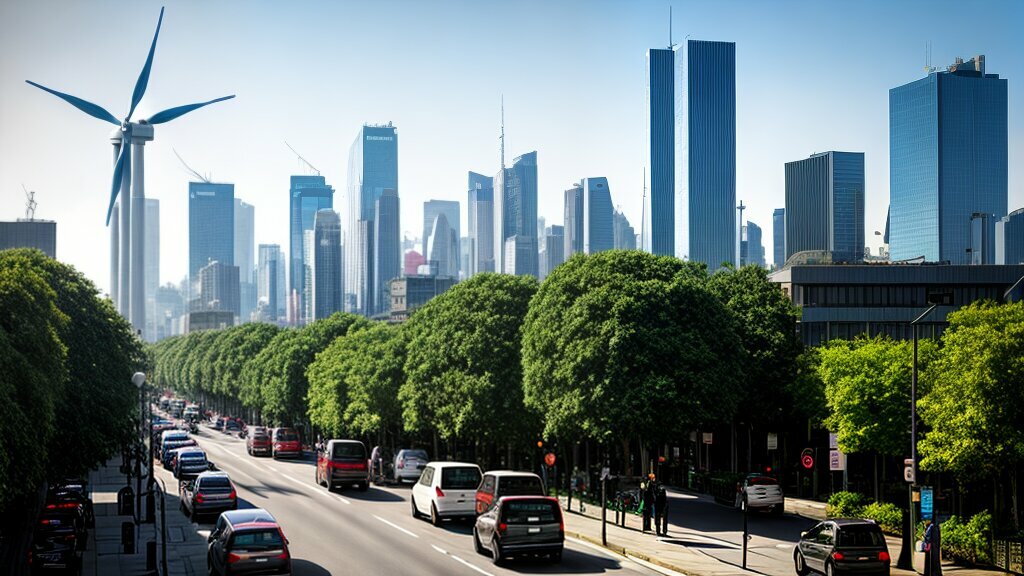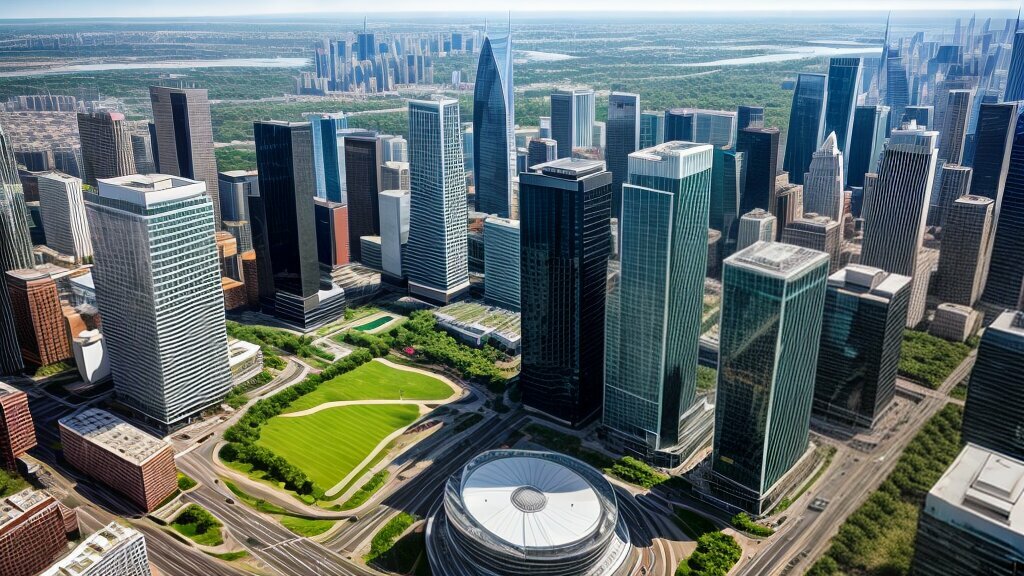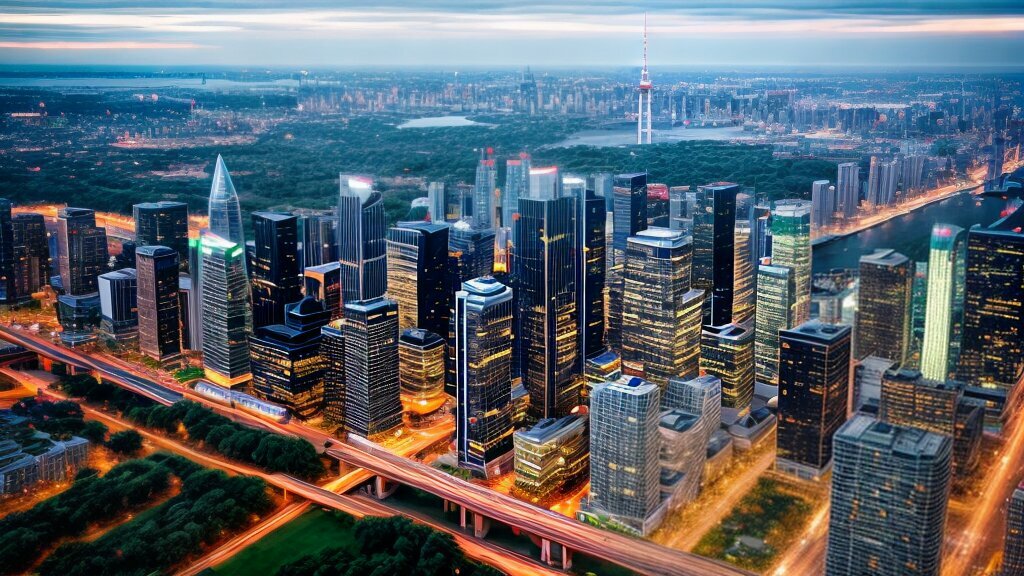Welcome to our article on the intersection of smart cities and sustainable building practices. In today’s fast-paced world, urbanisation is on the rise. Therefore, it is imperative to create eco-friendly and efficient urban spaces. This article will examine how smart cities and sustainable building practices can come together to create a better future for us all.
As the population grows, so does our need for efficient, sustainable, and technologically advanced cities. By leveraging data and innovative technology, smart cities can reduce their energy consumption, lower their carbon footprint, and create a better quality of life for residents.
Smart cities utilise digital technology to connect people, improve infrastructure and enhance the quality of life. Sustainable building practices, on the other hand, help to reduce the environmental impact of urbanisation by incorporating green infrastructure, energy-efficient buildings, and low carbon technologies.
Key Takeaways:
- Smart cities and sustainable building practices are interconnected
- The use of data and innovative technology can help reduce energy consumption and lower carbon footprint in cities
- Sustainable building practices can reduce the environmental impact of urbanisation
Understanding Smart Cities
In today’s rapidly growing urban environment, cities need to be intelligent and sustainable to meet the needs of their residents. Smart cities utilise digital technology, data collection and connectivity to enhance efficiency and enable sustainable development. These cities also incorporate sustainable building practices to reduce environmental impacts and promote resource efficiency.
Smart cities are urban areas that use information technology to enhance municipal services and improve citizens’ quality of life while reducing resource consumption and negative environmental impacts.
| What are the main elements of smart cities? |
How do smart cities contribute to sustainable development? |
- Digital technology integration
- Data collection and analysis
- Connectivity and communication
- Intelligent transport systems
- Smart energy management
- Waste management
|
- Improved resource efficiency
- Reduced environmental impacts
- Enhanced quality of life for residents
- Promotion of sustainable urban design principles
|
The integration of smart cities and sustainable building practices is necessary for creating eco-friendly and efficient urban spaces. Efficient urban planning and sustainable building practices are essential to reducing negative environmental impacts and increasing the quality of life for city residents. Smart cities and sustainable building practices will continue to evolve and shape the urban landscape, paving the way for a greener and more sustainable future.

Sustainable Building Practices for Smart Cities
Smart cities aim to create eco-friendly and efficient urban spaces that promote sustainable development and resource efficiency. One of the key elements of smart cities is the integration of sustainable building practices, which includes the use of green infrastructure and energy-efficient buildings.
Green infrastructure refers to the network of natural and semi-natural areas and features that provide various ecological, economic, and social benefits such as biodiversity conservation, climate regulation, and improved air and water quality. In the context of smart cities, green infrastructure can be used to mitigate the urban heat island effect, reduce flood risk, and enhance urban aesthetics and recreational opportunities. Examples of green infrastructure include green roofs, walls, and facades, parks and open spaces, and urban forests.
Energy-efficient buildings, on the other hand, are designed to minimize energy consumption and maximize energy savings. They typically incorporate features such as high-performance insulation, efficient lighting and appliances, renewable energy systems, and smart building controls that optimize energy use and occupant comfort. By reducing energy demand and using renewable energy sources, energy-efficient buildings can significantly reduce greenhouse gas emissions and enhance energy security in urban areas.
| Benefits of Sustainable Building Practices in Smart Cities |
| – Reduced environmental impact and carbon footprint |
| – Improved resource efficiency and cost savings |
| – Enhanced urban resilience to climate change and natural disasters |
| – Improved indoor environmental quality and occupant health and well-being |
Overall, sustainable building practices are critical for achieving the goals of smart cities and creating more livable, resilient, and sustainable urban environments.

Role of Renewable Energy in Smart Cities
Renewable energy plays a critical role in the development of smart cities. As cities grow and energy demand increases, it is becoming increasingly important to embrace low-carbon technologies and integrate them into the urban infrastructure. By integrating renewable energy sources, cities can reduce their carbon footprint and ensure a sustainable future.
Smart grids are a key component of renewable energy integration in smart cities. They allow for more efficient distribution of energy and increased use of renewable sources such as solar and wind energy. By using smart grids, cities can optimize energy usage and minimize waste, leading to cost savings and reduced emissions.
Low carbon technologies such as electric vehicles and energy-efficient buildings are also important in reducing the carbon footprint of cities. By investing in these technologies, cities can reduce energy consumption and promote sustainable living. For example, energy-efficient buildings use less energy to heat and cool, reducing overall energy consumption and emissions.
In addition to these technologies, renewable energy generation has become a key focus for smart cities. Using sources such as solar, wind, and geothermal energy, cities can generate clean energy locally, reducing reliance on fossil fuels and minimizing the environmental impact of energy production. This also provides an opportunity for cities to become more self-sufficient and resilient in the face of disruptions to the energy supply.

Overall, the integration of renewable energy sources is crucial in the development of smart cities. By embracing low-carbon technologies and investing in renewable energy generation, cities can minimize their environmental impact and promote a more sustainable future.
Benefits of Smart Cities and Sustainable Building Practices
By integrating smart cities and sustainable building practices, urban areas can enjoy numerous benefits. From energy efficiency to improved quality of life for residents, the advantages are significant and far-reaching. Here are just a few:
- Improved Energy Efficiency: By incorporating renewable energy sources, green infrastructure, and energy-efficient buildings, smart cities can significantly reduce energy consumption and lower greenhouse gas emissions.
- Reduced Emissions: Smart cities can help decrease pollution levels by promoting public transport, constructing bike lanes, and incentivizing electric vehicles.
- Enhanced Urban Resilience: Through smart technology and sustainable practices, cities can better prepare for and adapt to climate change and other potential disruptions to infrastructure and services.
- Improved Quality of Life: Smart cities can offer improved safety, better public services, and increased access to green spaces, all of which contribute to a higher quality of life for residents.
Together, these benefits demonstrate the positive impact that smart cities and sustainable building practices can have on urban areas and their inhabitants.

Challenges and Implementation Strategies
While the benefits of smart cities and sustainable building practices are undeniable, there are several challenges that must be addressed in order to implement these concepts on a large scale.
One of the main challenges is the high cost of implementing smart technologies and sustainable building practices. Many cities and developers may be deterred by the initial investment required to make their buildings and infrastructure more eco-friendly and energy-efficient. Additionally, there may be resistance to change from those who are accustomed to traditional urban planning and construction methods.
To overcome these challenges, it is important to demonstrate the long-term cost savings and environmental benefits of adopting smart city technologies and sustainable building practices. Cities and developers must also work to educate the public on the advantages of these concepts, and collaborate with stakeholders to develop and implement policies that promote eco-friendly and efficient urban spaces.
Successful Implementation Strategies
Several cities have successfully implemented smart city technologies and sustainable building practices, providing examples that can be used as models for others:
| City |
Initiative |
Outcome |
| Singapore |
Smart Nation |
Improved urban planning and resource efficiency |
| Amsterdam |
The Amsterdam Approach |
Reduced greenhouse gas emissions and improved air quality |
| New York City |
PlaNYC |
Decreased energy consumption and increased use of renewable energy sources |
By learning from these successful initiatives and tailoring them to their own unique contexts, cities and developers can overcome the challenges of implementing smart city technologies and sustainable building practices.

“The most successful smart city initiatives are those that embrace collaboration and stakeholder engagement, and leverage data and technology to improve urban sustainability and resilience.”
Case Studies: Smart Cities and Sustainable Building Practices in Action
Real-world examples of successful integration of smart cities and sustainable building practices can provide valuable insights and inspiration for cities around the world. Let’s take a look at some case studies:
Stockholm, Sweden

Stockholm has been recognized as one of the world’s leading smart cities, thanks to its innovative approach to sustainability. The city has set a goal to be fossil-fuel-free by 2040 by integrating smart technology with energy-efficient buildings and transportation. The Royal Seaport, a growing district in Stockholm, is a prime example of sustainable urban development. It features green infrastructure, including a stormwater collection system and green roofs, as well as energy-efficient buildings with smart heating and cooling systems.
Portland, USA
Portland is another city that has made strides in sustainable urban development. The city’s EcoDistrict program focuses on neighborhood-scale sustainability, incorporating green infrastructure, renewable energy, and community engagement. One of the most notable examples of sustainable building practices in Portland is the Oregon Convention Center, which features the largest solar array on any convention center in North America, as well as a green roof and rainwater harvesting system.
Copenhagen, Denmark
Copenhagen has a reputation for being one of the most livable cities in the world, thanks in part to its commitment to sustainability. The city’s sustainable initiatives include a district heating system, which uses waste heat from power plants to provide heating for buildings, and an extensive network of bicycle paths. Its Nordhavn district, a former industrial port, is being transformed into a sustainable urban area with energy-efficient buildings, smart streetlights, and an integrated water management system.
These case studies demonstrate the potential for smart cities and sustainable building practices to create more livable, eco-friendly urban spaces. By integrating technology, renewable energy, and green infrastructure, cities can reduce their environmental impact while improving quality of life for residents.
Future Trends and Innovations
The future of smart cities and sustainable building practices looks promising, with ongoing advancements in technology and urban design. These innovations will enable cities to become more eco-friendly, resource-efficient, and resilient to the challenges of urbanisation and climate change.
One emerging trend in smart cities is the use of autonomous vehicles (AVs) to reduce traffic congestion and emissions. AVs can also improve mobility and accessibility for people with disabilities or limited mobility, as well as reduce the need for parking spaces, allowing for more green spaces in urban areas.
Another exciting development is the use of 3D printing technology to build sustainable structures using recycled materials. This approach can significantly reduce the environmental impact of construction and speed up the building process.
The Internet of Things (IoT) is also playing an increasingly important role in smart cities, with sensors and devices collecting data and providing real-time insights to city planners and residents. This technology can improve energy efficiency, monitor air quality, and enhance public safety.
Other future trends include the development of smart grids, which will enable better management of energy resources, and the use of blockchain technology to create secure and transparent systems for managing urban infrastructure.

As these innovations continue to evolve, it is essential to ensure that they are inclusive and equitable, benefiting all members of society. City planners and policymakers must consider the social and economic implications of these technologies, to ensure that they do not exacerbate existing inequalities.
Conclusion
In conclusion, the integration of smart cities and sustainable building practices is crucial for promoting a greener and more sustainable future. By leveraging digital technology, data collection, and connectivity, smart cities can contribute to efficient urban planning and sustainable development.
Incorporating sustainable building practices such as green infrastructure and energy-efficient buildings can help reduce environmental impact and promote resource efficiency. Additionally, the integration of renewable energy sources, smart grids, and low carbon technologies can lead to cleaner and more sustainable urban energy systems.
The benefits of smart cities and sustainable building practices are numerous, including improved energy efficiency, reduced emissions, enhanced urban resilience, and an improved quality of life for residents. However, there are challenges associated with implementing these practices, such as high costs and resistance to change.
To encourage widespread adoption, strategies and examples of successful implementation must be provided. Real-world examples of successful smart technologies and sustainable building practices have shown positive outcomes and lessons learned that can be applied to future projects.
As emerging trends and innovations in technology, urban design, and policy shape the future of eco-friendly and efficient urban spaces, it is important to continue to integrate smart cities and sustainable building practices. This will help create a greener and more sustainable future for generations to come.
FAQ
Q: What are smart cities?
A: Smart cities are urban areas that utilize digital technology integration, data collection, and connectivity to enhance the efficiency and sustainability of urban planning and development.
Q: How do smart cities contribute to sustainable development?
A: Smart cities promote sustainable development by incorporating eco-friendly and resource-efficient practices, such as renewable energy generation, efficient waste management, and intelligent transportation systems.
Q: What are sustainable building practices in the context of smart cities?
A: Sustainable building practices in smart cities involve the use of green infrastructure and energy-efficient buildings to minimize environmental impact and promote sustainable urban development.
Q: What is the role of renewable energy in smart cities?
A: Renewable energy plays a crucial role in smart cities as it helps to reduce carbon emissions and promote cleaner and more sustainable urban energy systems. Smart grids and low carbon technologies further enhance the integration of renewable energy sources.
Q: What are the benefits of smart cities and sustainable building practices?
A: Smart cities and sustainable building practices offer numerous benefits, including improved energy efficiency, reduced emissions, enhanced urban resilience, and an improved quality of life for residents.
Q: What are the challenges associated with implementing smart cities and sustainable building practices?
A: Challenges in implementing smart cities and sustainable building practices include high costs, resistance to change, and the need for collaboration between various stakeholders. However, adopting strategies and learning from successful case studies can help overcome these challenges.
Q: Can you provide examples of smart cities and sustainable building practices in action?
A: Examples of smart cities and sustainable building practices in action include cities like Barcelona, Singapore, and Copenhagen, which have successfully implemented technologies and practices to create more sustainable and efficient urban spaces.
Q: What are the future trends and innovations in smart cities and sustainable building practices?
A: Future trends in smart cities and sustainable building practices include advancements in technology, urban design, and policy that focus on creating greener and more sustainable urban environments.

























Post comments (0)